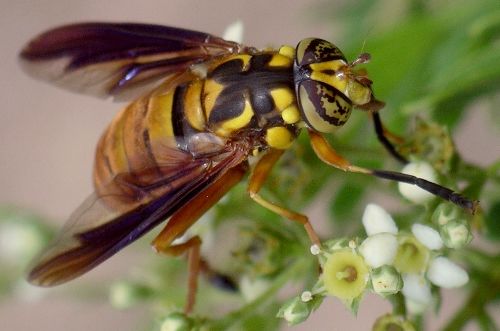by Valerie
October, 2009Yellowjacket Mimic Syrphid
In honor of the upcoming Halloween holiday, this month's backyard beast features a true masquerader. What looks convincingly like a southern yellowjacket queen (Vespula squamosa) is actually a yellowjacket mimic syrphid (Spilomyia alcimus). This fascinating insect does not have a traditional colloquial name, so I simply gave it a descriptive one. While not numerous, it does show up regularly in the spring, feasting on the nectar of flowers. This is a true fly, in the order Diptera. It is in the family Syrphidae, commonly called hover or flower flies. The family contains many wasp and bee mimics, and this particular species has one of the most elaborate costumes. Although their body shapes are similar, flies differ superficially in several respects from wasps, such as having two wings instead of four, larger eyes, and shorter antennae. It certainly makes sense that many flies, with little natural protection of their own, have evolved to mimic something a bit more dangerous, and resembling a large stinging wasp is definitely a good way to give predators pause. As one of the largest of syrphid flies, this species is in fact the same size as a real queen yellowjacket. The basic colors are so close that it can fool even discriminating eyes, such as those of birds. The abdomen matches perfectly, the thorax is close, and even the legs are the same color. The wings have dark markings that make it look as if there are two pairs instead of just one. The large eyes have dark bands to give the impression of a smaller eye with a light band behind it, just like the model has. The fly is still missing the long black antennae of the wasp. If threatened though, it will hold its black front legs out and wave them up and down in a very good imitation of the movements of the wasp's antennae. Even when the fly is simply feeding at flowers, it moves just like wasps do, clambering about on the flowers more often than flying between them, and rarely pausing in its foraging. Such an amazing impersonator must be seen firsthand to fully appreciate its design. During the spring, be sure to take a second look at the "wasps" feeding on small, densely packed blossoms. |